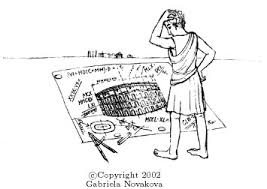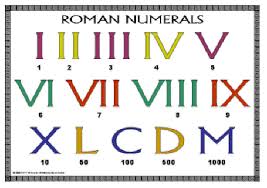{Compiled by: Kandiah Thillaivinayagalingam]







"He is also numbers and letters So coveted by those of the sea-girt earth,He is The nature (of all things)"-Thirunavukkarasar;

In above sumerian system, to represent "59" we still requires five tens and nine ones.But other civilizations, for example the Maya of Central America and the Romans, were more adapt at combining a main base and auxiliary base in ways that avoided the repetition of symbols beyond five.Roman numbers are much easier to read than Sumerian numbers because they use the decimal system familiar to us, and because they are not written in pictorial form but use letters of the alphabet. The well-known Roman numerals are
A Roman number never requires the repeat of more than 4 identical symbols, which makes reading Roman numbers relatively easy.
[Tamil-Brahmi cave inscription from Tondur(3rd century C.E.) Here The numeral 3 engraved at the end of a short two-line inscription in the cave is represented by three horizontal parallel lines.The inscription records that the village of Agalur gifted three stone beds in the cave chiselled by Mosi]
A well-preserved pottery inscription from Alagankulam near Rameswaram.The inscription is dated to the 1st or 2nd century C.E. IRAVATHAM MAHADEVAN said the number is read 408,The first digit at right looking like the cross is the symbol for 4.It is followed by the symbol for 100 (resembling the Brahmi letter sa) and the last symbol at left is 8, incised in reversed direction.However N.Ganesan stressed it is 804,]
It is easy to see the origins of a decimal (base 10) number system. Our hands have 10 digits [fingers] to count on, so a decimal system follows naturally.With the addition of the toes on our feet a vigesimal (base 20) number system, like that of the Maya, also makes sense. But understanding a sexagesimal (base 60) number system, as used by the Sumerians, takes a little more thought .By using the thumb as a pointer, and marking off the each finger bone[the distal phalanx, middle phalanx and proximal phalanx] on the four fingers in turn, we can count up to 12 on one hand,For example,Each of your fingers except thumb has three distinct segments. and, touching now the middle segment of your right index finger with your right thumb,means: “Two.”Now, similarly count all segments in your right hand fingers with right hand thumb and having successfully counted to 12, make a thumbs-up sign with your left hand.As in . . . “that’s one set of 12.” Count another set of twelve with your right hand and you earn an unfolded left index finger . “That’s two sets of 12.”Keep doing this until you have unfolded all five fingers of your left hand, and you’ve got 60!
When the Sumerians first came up with their numerals, they did not have a specific symbol for zero and no concept of 0 as a number, which created ambiguities in positional notation.Neither the Sumerians nor other people in Mesopotamia (most notably, the Babylonians) were able to come up with a solution at the time. This issue would remain unsolved until around 500 A.D. when the Indians developed the Arabic numerals that we are still using today.As such the sumerian number 60 was represented by the same symbol as the number 1 & the actual place value of a symbol often had to be inferred from the context!
"By My eyes have lost their brightness, sight is dimmed; my fingers worn,
With nothing on the wall the days since I was left forlorn."-Thirukkural 1261
Which says:My finger has worn away by marking (on the wall) the days he has been absent while my eyes have lost their lustre and begin to fail.So there must be a number system/numerals during sangam period.Further,The Ancient Poetry (anthology) ” Paripadal” of the Sangam period reveals to us the truth where numbers should start.Paripaadal (பரிபாடல்) is mentioned as the 5th group of verses in the Sangam compilation of "ettu-th-thogai" (எட்டுத் -தொகை ) and is possibly the oldest religious composition in Tamil.That is,Tamils learnt the art of counting (numerals) first. This they called mathematics (Kanakku). They gave figures to indicate it. This mathematics had only a few figures. But alphabetic has more letters, so, they was called it lengthy mathematics. (Nedung Kanakku)
Paazh (Zero/ go to ruin ,land waste by drought . dead-loss/ஒன்றுமில்லா ஊழி/பாழ் என்றால் எதுவுமற்ற வெறுமை என அர்த்தம்.) and Kaal (Quarter) and Paagu (half) and oneru (one) and Erandu (Two) and Moonru (Three) And Nangu (Four) and inthu (Five) and aaru (Six) and Ezhu (seven)and Ettu (Eight) and Thonndu (Nine) ……(PARIPADAL 3 ; 77-80).
Also we do have ancient literary references specifically mentioning eN (‘numeral') as distinguished from ezhuttu [‘letter of the alphabet,' for example, Tolkappiyam 655.4, Tirukkural 392.]
PART :28 WILL FOLLOW in nextweek









valuable information
ReplyDelete